
Warm Apple-Cinnamon Buns
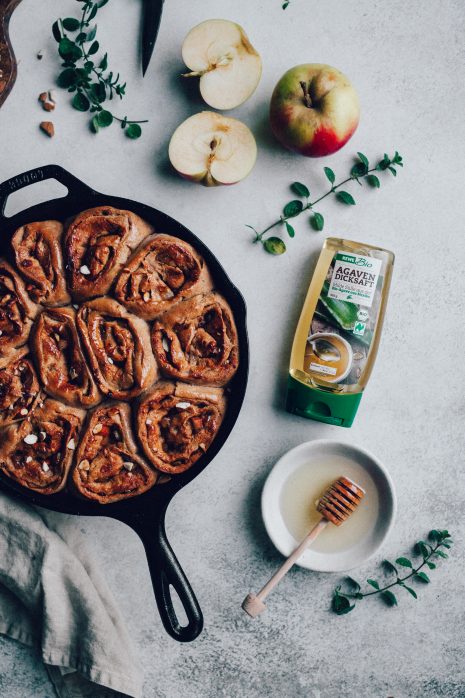 Little heads up: This blogpost is in German. So sorry for that. However! If you scroll down, the recipe and notes are all in English!
Little heads up: This blogpost is in German. So sorry for that. However! If you scroll down, the recipe and notes are all in English!
Und plötzlich haben wir Herbst. Nach einem langen und unglaublich sonnigen Sommer fallen allmählich die Temperaturen und das alltägliche Leben in Berlin zieht sich wohl oder übel von den Straßen in die eigenen vier Wände zurück. Ich muss zugeben, es gefällt mir. Kerzen und literweise Tee haben sich bereits in meinen Alltag wieder fest verankert. Ebenso wie mein verlässliches Craving für Süßspeisen, was sich immer bei Temperaturen unter 20°C beharrlich einnistet. Aber da es weitaus schlimmeres gibt, gebe ich mich dem gerne hin. So entstand auch dieses Rezept, was ich heute mit euch teilen möchte. Apfel-Zimtschnecken. Seit klein auf habe ich ein besonderes Faible für sie, doch hielt ich die Zubereitung für viel zu kompliziert, als sie selbst zu backen. Stellt sich heraus: dem ist nicht so. Obgleich der Hefeteig für eine Stunde gehen muss, so kann man diese ganz gut nutzen um die verwüstete Küche wieder auf Vordermann/frau zu bringen.
Auch freue ich mich, dass ich für diesen Blogpost erneut mit REWE Bio zusammenarbeite. Vor einigen Wochen fragten sie mich, ob ich nicht ein Rezept mit ihrem Agavendicksaft erstellen möchte und stellten mir ihr Projekt „Weil Bio nicht gleich Bio ist“ und ihre Zusammenarbeit mit Naturland vor.
Zu allererst muss man erwähnen, dass es eine einheitliche EU-Öko-Verordnung gibt, an die sich alle Produzenten halten müssen, wenn sie ein solches Bio-Label erhalten wollen. (Das ist das grüne Label mit den zu einem Blatt angeordneten Sternen.) Nur wenn die Produkte diese europäischen Richtlinien erfüllen, dürfen sie zum Beispiel auch als „biologisch“, „bio“, „öko“ usw. verkauft werden. Hier findet ihr ein paar mehr Infos zur allgemeinen EU-Öko-Verordnung.
Da kommt Naturland ins Spiel. Ein internationaler Verband für ökologischen Landbau und unter anderem ein Produzent für REWE Bio. Sie verfolgen einen ganzheitlichen ökologisch-sozialen Ansatz und setzen sich weitaus strengeren Bio-Richtlinien aus, als die EU-Öko-Verordnung vorgibt.
Zwar spielen die ökologischen Richtlinien für Naturland ebenfalls eine große Rolle – so sind Naturland Höfe zu 100% Bio, um eine Kontamination und Verwechslung mit Nicht-Bio-Produkten auszuschließen – doch auch werden auf die Sozial-Standards großen Wert gelegt. (Welche bisher leider noch nicht in der EU-Öko-Verordnung festgehalten sind.) So umfasst der Richtlinienkatalog unteranderem die Punkte Menschenrechte, freie Arbeitswahl, Gleichstellung, Kinderrechte, Gesundheit und Sicherheit.
In Produktionsländern achtet Naturland stark auf soziale Verantwortung. Zum Beispiel durch Kontrolle von Gesundheit und Sicherheit am Arbeitsplatz (bei der Agavenernte wird beispielsweise darauf geachtet, dass jeder Arbeiter einen Beinschutz trägt und sich somit vor Verletzungen mit den scharfen Rundmessern schützt). Auch wird sich stetig um Gleichstellung und feste Arbeitsverträge für alle Arbeiter gekümmert. Mehr Informationen könnt ihr auf www.naturland.de finden. Dort gibt es unter anderem eine Gegenüberstellung der EU-und Naturland-Richtlinien, welche ich ziemlich interessant finde, um mal einen Überblick zu gewinnen, was alles als „Bio“ bezeichnet werden darf.
Bei der Herstellung von Agavendicksaft, kann man die Philosophie von Naturland sehr gut erkennen. Agavendicksaft wird aus der Blauen Agave gewonnen, die in Mexiko angebaut wird. Da die Agave ganzjährig angebaut wird, wird besonders darauf geachtet dem Boden ausreichend Nährstoffe zukommen zu lassen. Dies geschieht durch Untersaaten und Wildkräutern, was wiederum die Ansiedlung von Nützlingen fördert. Auch dürfen beim Anbau keinerlei chemisch-synthetische Pflanzenschutzmittel eingesetzt werden. Die Düngung geschieht lediglich durch Mulch der Beikräuter und den Mist von den auf den Flächen weidenden Kühen und Pferde. Bei der Verarbeitung der Pflanze zum Sirup wird dann nur mit möglichst niedrigen Temperaturen gearbeitet, um möglichst viele Nährstoffe zu erhalten.
Um sicherzustellen, dass diese Punkte auch eingehalten werden, gibt es jährliche Kontrollen und eine transparente Rückverfolgbarkeit, damit am Ende genau klar ist, welche Stopps die Produkte vom Bauern bis hin zu uns gemacht haben.
Ich fand es ziemlich spannend mich in dieses Thema einzulesen, da ich zugeben muss, dass ich bis dato nur wenig über das Bio-Siegel und seine Kriterien wusste. Es ist schön zu sehen, dass sich REWE Bio für einen verbesserten ökologischen Kreislauf einsetzt.
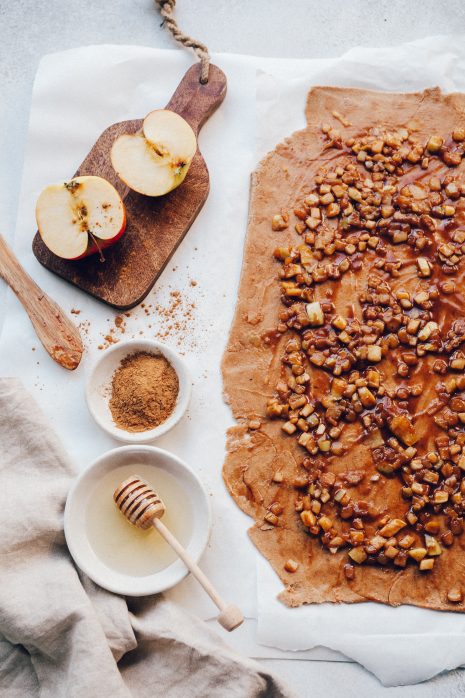
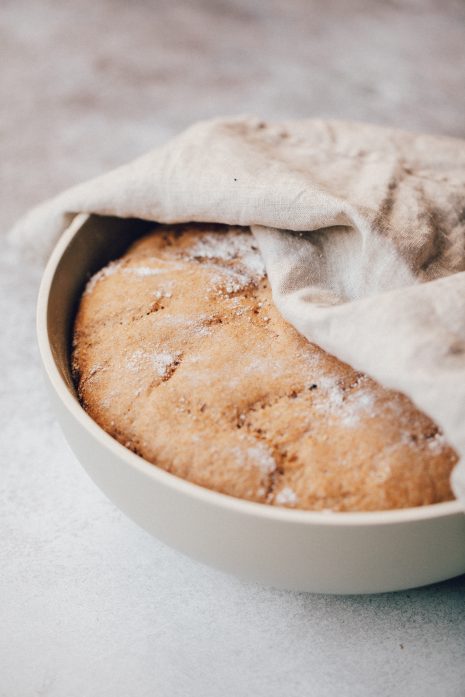
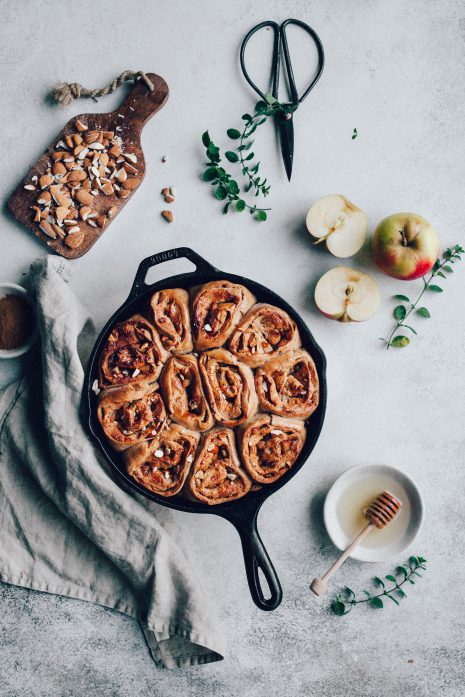

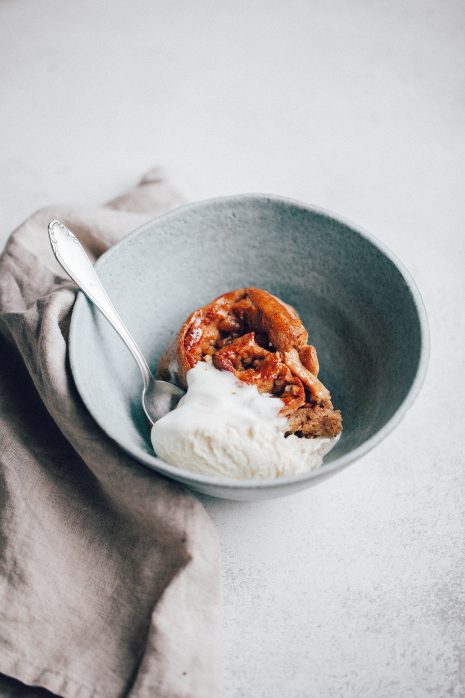

Back to the recipe! There are one or two notes that I wanna give for this recipe. After many, many attempts, I had to admit that I had to use some wheat flour in this recipe in order to get this certain “fluffiness” that we all love in cinnamon buns. Therefore, I have developed a mixture of wholegrain spelt flour and wholegrain wheat flour where the dough and buns rise sufficiently and become loose and fluffy. Alternatively, you can replace the wheat flour with almond flour, but they will be a little smaller and not as soft. However, still very tasty of course!
Also, I used a little butter in the recipe. If you do not feel like using any, you can easily replace it with coconut oil.
And last but not least: the recipe is not super sweet, so it’s up to you if you want to add more sweetness to the dough. My personal favorite is to serve the cinnamon buns with ice cream. This way warm meets cold and mild sweet meets pretty sweet. Tada!
I wish you a lot of fun trying them out!
Warm Apple-Cinnamon Buns Recipe
- Prep Time: approx. 30 minutes, plus 1 hour of dough rising, plus 40 minutes of baking
- Servings: 12 - 14 cinnamon buns
Ingredients
For the yeast dough: 300 ml of plant milk (250 ml + 50 ml) 1.5 packs of dried yeast (about 10g) 3 tablespoons coconut sugar 350 g wholegrain spelt flour, plus something for dusting 350 g wholegrain wheat flour 1 pinch of salt 1 ½ tsp ground cardamom 1 ½ tbsp cinnamon ½ teaspoon ground vanilla 100 g organic butter or coconut oil 4 tablespoons of natural sweetener (eg REWE organic agave syrup) For the filling: 125 g organic butter or coconut oil 4 tablespoons natural sweetener (eg REWE organic agave syrup) 2 teaspoons cinnamon 1-2 apples 1 handful of chopped almondsInstructions
- For the yeast dough heat up 50 ml of plant milk in a pot, do not bring to boil! Then stir in yeast and coconut sugar. Remove from the heat and let stand for at least 10 minutes. The yeast should be dissolved and small bubbles appear on the surface.
- In a large bowl, mix all the dry ingredients together and press in a little hole in the middle of the dry dough. Add the yeast milk in the hole and mix everything with a fork to a dough. (The easiest way is to use a stand mixer). Then add butter and sweetener to the dough and mix until smooth.
- Form the dough into a ball, sprinkle with a little flour and let it rise covered up in a bowl for 1 hour in a warm place.
- Dust the work surface with flour and then roll out the dough to a rectangle about 1 cm thick. It is best to place the dough between two layers of baking paper.
- For the filling, heat up butter in a saucepan at medium temperature until it turns slightly brownish. (If coconut oil is used here, all ingredients can be mixed together right away.)
- Meanwhile, wash the apple and cut into small cubes. Add agave syrup, apple pieces and cinnamon to the brown butter. Simmer for 5 minutes. Then remove from the heat and allow to cool slightly.
- Distribute the filling evenly on the rolled out dough, then sprinkle with chopped almonds. Roll up the dough from the longer side.
- Preheat the oven to 175 ° C.
- Carefully divide the roll into 12-14 equal pieces with a sharp knife (or dough cutter). Place thee rolls side by side in a suitable baking dish (or lower pan).
- Bake the cinnamon rolls in the oven for 30-40 minutes. Let them cool off slightly. Coat with a little extra agave syrup and serve with ice cream if you'd like.
 Follow
Follow
